Retreatment of Thermafill Carriers
Thermafil gutta percha carriers were introduced to the dental community by Tulsa Dentsply in the 80’s.
And over the years the product has change somewhat, but the idea remains the same. Essentially the product consists of gutta percha that surrounds another type of material which serves as the “carrier” of the gutta percha. Originally the carrier was a very thin metal that resembles a handfile. The metal based carrier phased out fairly quickly and was replaced with the most common carrier system which is a plastic.
In figure 1, you will see an assortment of thermafil carriers of different sizes. Notice the obvious pinkish gutta percha that surrounds the “carrier” which runs through the middle of the gutta percha and extends out to the handle section. In this figure the carrier is a plastic core. I have also included a case I am currently treating with metal Thermafil carriers. Notice in the pre-operative x-ray the “file-like” appearance of the material in the mesial canals. This is easily mistaken for separated files. However you can see upon removal of the carriers there is gutta percha around the metal carrier. I also included an x-ray of calcium hydroxide in the canals following full instrumentation and the completed case.
Figure 1

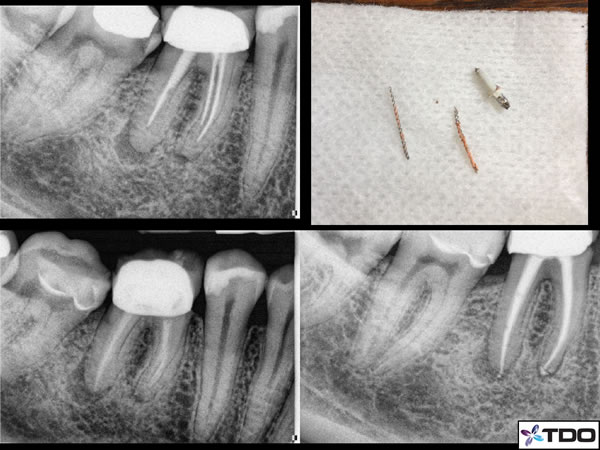
This blog is not specifically intended to review the merits of the Thermafil carrier obtruation system, but I will say that Thermafil has in general been a “love it” or “leave it” product. By enlarge the endodontic community has shunned the carrier based obturation systems. Specifically the concerns were with regards to retreatment of the material. But the product line has been quite a strong seller for Dentsply Tulsa as there are some conceptual advantages of the product. Additionally Dentsply Tulsa has made another change to the product that will likely result in more acceptance within the endodontic community. As for our office, we have not used the material for obturation because we do share the retreatment concerns similar to the majority of the endodontic community which brings me to the point of this blog.
Retreatment of Thermafil carriers can be tough. Unlike retreatment of a canal of gutta percha with Thermafil carriers there is a second material that must be removed; metal or plastic. Removing these materials is not at all the same as a homogeneous canal full of just gutta percha. Gutta percha is soluble in a chloroform solvent where as the metal and plastic are not (or in the case of the plastic not nearly as soluble). Even without solvent gutta percha can still be penetrated with hand or rotary files because there is a reasonable softness to the material. The metal or plastic carriers are much more dense, thus penetrating the material is tough and/or impossible. It is not uncommon to have cases in which removal of these materials can tack on an hour or two more onto the retreatment process. But none-the-less these carriers must be removed in order to fully reshape, irrigate, and properly clean the canal system.
I thought it might be of some interest to know how we remove Thermafil carriers. There are some unique techniques that we use to remove these Thermafil carriers that can reduce time and frustrations, and result in predictable outcomes. There are three techniques I want to share in this blog; the braiding technique, the System B plugger technique, and using a centrix syringe with a dual cure composite.
Braiding Technique:
This technique uses the file design of an H (Hedstrom) file to entwine the carrier and pull it out. The H-file is unique in that it has a positive rake angle (see figure 2). This rake angle of the file allows the file to engage the carrier with more friction and binding strength.
Figure 2
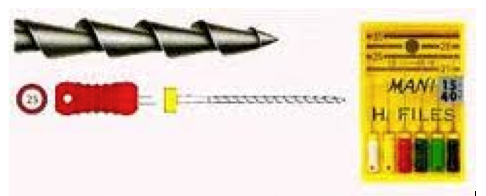
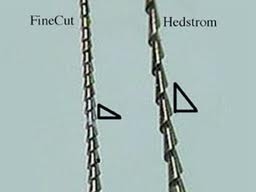
Notice the angle the file design has with each flute. This rake angle gives a greater amount of engagement into the carrier material.
Thus the concept would be to introduce the H-file to a sufficient length alongside the carrier in order to get the binding and engagement of the file’s rake angle into the carrier. However just one H-file will not engage the material well enough. Although it will bind the carrier somewhat on one side, upon file removal only the file will pull out of the canal. What we need is 2 or maybe 3 H-files to be placed alongside the carrier material so that we can engage the carrier on 2 or 3 sides. The only way to get multiple files alongside the carrier is to use the dissolution properties of gutta percha to soften the gutta percha so that the files can be moved apically on more than one side. Remembering that Thermafil carriers are surrounded by gutta percha (refer back to figure 1) we can start with very small size 6 or 8 C-files and a solvent to dissolve the gutta percha around the carrier material. Once we have handfiled up to a 15 file along one side of the carrier and through the gutta percha we will need to do that to another side. So for example, if we file up to a 15 file on the buccal side of the carrier material, we will need to do that same process to the lingual side of the carrier material as well.
At this point we can introduce size 15 H-files into the buccal and lingual sides of the carrier material (figure 3). Often times 2 H-files can work well, but a well fit carrier will require more. We will often need to introduce 3 H-files on 3 sides of the material in order to create more engagement into the carrier.
Figure 3
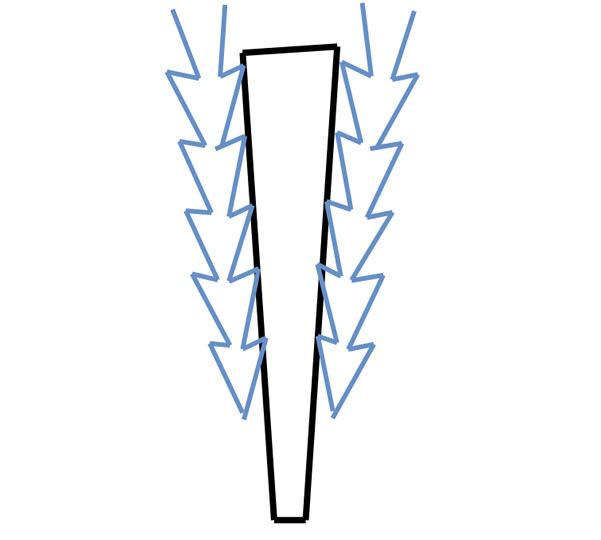
This shows how a H-file with the positive rake angle can engage the carrier walls and how 2 H-files would look on opposite sides of the carrier.
Once the files are placed we “braid” the files with our fingers to twist them and lock them around the carrier. This will now create significantly more engagement onto the carrier so that when pulling the files coronally we have a much better chance to remove the carrier (figure 4).
Figure 4
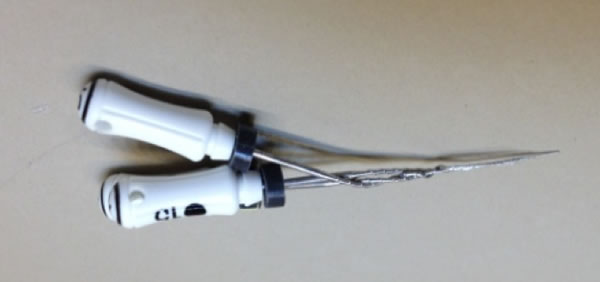
This image shows 3 size 15 H-files “braided” together. You can see the grip created as the files intertwine. Imagine a carrier based material locked within that grip. With the fingers pulling coronally, the carrier locked within these files will eventually be removed.
One thing to remember is that rarely will a carrier dislodge at one attempt of this braiding technique. It always requires many attempts using new H-files and continuous repetition with standard hand filing and solvent use throughout. But patience typically always results in removal of the carrier material. The metal carriers in figure 1 were removed with this braiding technique.
System B technique:
This technique is so quick and easy when it works. However, in my experience I can successfully remove a plastic based carrier about 60-65% of the time. Thus the other 35-40% of the time I will need to fall back on a standard pick and peck of the material with C-files or the braiding technique.
The System B is an instrument that most endodontist use for obturation. An operator will place a master cone in the canal space and use the System B to melt through the master cone which provides warmth to the gutta percha and compaction pressure in order to fill the space more completely. In using the System B we can achieve a more 3 dimensional root fill and theoretically the ramifications and crevices of the canal system is obturated with gutta percha and sealer. In figure 5 I have place a picture of the System B unit and a picture of the tip that fits the System B. The tip heats up instantly and to a temperature set by the operator. The tip is what plunges through the master cone and condenses apically while still hot.
Figure 5
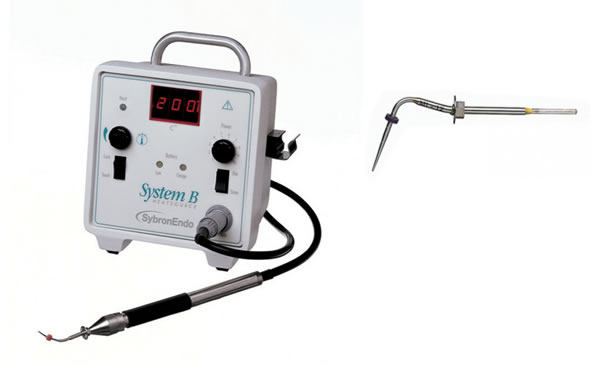
In the retreatment of Thermafil carriers we can use this unit to our advantage. We will increase the temperature setting to around 400 degrees and position the tip of the System B plugger directly on top and in the center most point of the plastic carrier at the specific level of the orifice of the canal. We then activate the tip to instantly become very hot and push the tip through the plastic core as far as we can. We push anywhere from 3-8mm into the core depending upon the curvature and size of the canal space. However the deeper set the System B tip the better.
Of course we do not want to activate this very hot temperature for more than a couple of seconds. The patient will not feel anything (assuming properly numb) and the quickness of the process will not result in much raised temperature to the dentin or ligament space.
At this point we will allow about 2-3mins for the System B tip to cool down entirely and allow the plastic core to stick to the System B tip. I will often help to cool the tip using an air stream from the air-water syringe.
Once we feel there has been enough cooling we then position our fingers of both hands upon the tip (not the System B handle) and pull straight out of the canal and lift out the plastic Thermafil core still attached to the System B tip (figure 6).
Figure 6
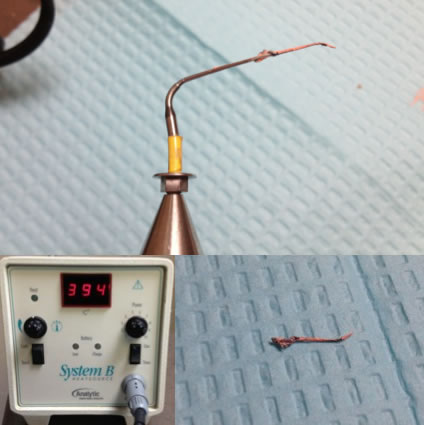
These three images show a recent case in which I removed the Thermafil plastic carrier with the System B tip. You can see the System B tip plunged through the plastic and the plastic then adhered to the tip.
This process for one canal can take no more than 3 minutes if successful. I have had retreatment cases of molar teeth with 3 canals where I have removed all 3 Thermafil carriers within 5 minutes. That is a good feeling.
But as mentioned before this technique is not always successful. Furthermore, it cannot be used with metal Thermfil carriers. However, given the challenge often associated with retreatment of Thermafil carriers it is worth trying this technique at the beginning of treatment upon access and scouting out the materials in the canal spaces.
Centrix Syringe – Dual Cure Composite Technique:
This last technique I wanted to review uses a standard Centrix Syringe tip and a dual cure composite material (we use Luxacore). It is only useful for metal Thermafil carriers or silver points.
In order to use this technique, we will need to expose about 4mm (more if possible) of the metal carrier so that the centrix syringe tip can cover the carrier. In other words the metal carrier will fit within the centrix syringe tip.
We then express a dual cure composite through the centrix tip so that the centrix tube and tip is full of composite. I can then bend the centrix tip and fit the tube over and around the exposed metal carrier surface. Thus the metal extends within the tube where the dual cure composite remains. By using the dual cure composite we simply wait for a few minutes while the composite sets up and locks the metal carrier in place. With a good frictional bond we can pull the centrix tip and metal carrier out as one piece (see figure 7).
Figure 7

Here is a case I completed with 3 metal Thermafil carriers. I removed all 3 carriers with this Centrix Syring–Dual Cure composite technique. The picture shows the metal carriers within the centrix tube and you can see the pinkish gutta percha present as well.
These are just a few tricks that can be used to help with retreatment of Thermafil carrier based obturation systems. They do not always work and sometimes we will use a combination of these techniques to remove the material. However, with repeated use of these techniques we have found that we can remove Thermafil carriers quite predictably. Of course sometimes we simply rely upon the pecking and picking of standard hand files, but given the challenges of retreatment in these types of cases, we will try anything to make our lives easier.
Another solution might simply be to replace the metal or plastic carrier material with a different and just slightly harder form of standard gutta percha. And indeed Dentsply Tulsa is making that transition now. Stay tuned for more information in the future on this new product on the market called Gutta Core.
Thanks for visiting Tri-City and Fallbrook Micro Endodontics, serving the greater San Diego, CA area.
